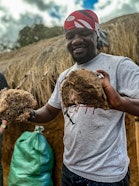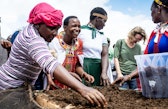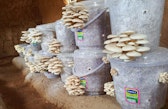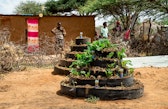The proof is in the poop
Project Update
Publish date: March 18, 2024

Powering local prosperity through green growth
Powering local prosperity through green growthThe proof is in the poop
Project Update
Powering local prosperity through green growth
Powering local prosperity through green growthPublish date: March 18, 2024
Mushroom farming using elephant dung substrate a boon for rural development
[NANYUKI, Kenya] It's not too often that we think about how our food is grown, just that it looks good and tastes even better. What if we told you that some of the best tasting mushrooms are being grown using elephant dung as a substrate? Yes, for real. Residents of the semi-arid Naibunga Community Conservancy, located in Kenya’s Laikipia county, have been testing out a new way to grow oyster mushrooms, a crop previously unheard of in their meat-dense diet. This novel farming technique uses treated elephant dung—which is largely semi-digested plant material—in place of soil to plant the mushrooms. The dung substrate is packed with nutrients that allow food to grow without any extra inputs, such as fertilizer.
Processing elephant dung substrate is simple but time consuming. Once the dry elephant dung is collected, it is sorted, and then soaked in water for 24 hours to separate the substrate from other matter in the dung. Next is pasteurization through steaming, achieved using locally available materials like a large metal drum. Water is added into the drum and set over a fire to produce steam, and the previously soaked dung is placed above the steam—while covered—and left for four hours. This process kills any unwanted micro-organisms, and the resulting substrate is cooled before mushroom seeds are added to it. The planted mushrooms are then transferred to the “mushroom house” where light and humidity levels are kept constant, allowing for optimal growth. After 21-28 days, the mushrooms are grown and ready for harvest.
This cultivation approach has been 13 years in the making, and finally came to fruition through a partnership between the Wyss Academy for Nature (WA), the National Museums of Kenya (NMK), and community group Green Earth Warriors.
Antony Wandera, Projects Manager at the Wyss Academy for Nature Hub East Africa, and originator of the idea, shares:
“Working out in the field, and on various projects around rhinos and elephants, I wondered if in addition to conservation, food security could also be a consideration for the communities we work in. So I floated the idea of growing mushrooms on the readily available elephant dung to a few organizations, but nothing came of it until I joined the Wyss Academy, where the idea was embraced. Our partnership with the NMK, who also saw the potential in the idea, and are now deeply invested in its success.”
The mushroom project began with a baseline biodiversity survey conducted jointly by the Wyss Academy and the National Museums of Kenya in August 2023. The survey determined the potential of mushroom farming as a local sustainable livelihood strategy, evaluated the viability of elephant dung as a substrate for mushroom cultivation, and identified the oyster mushroom as a suitable variety for trial farming and consumption.
Victor Otieno, Lead Researcher specializing in mycology (study of fungi) at the NMK, remarked, “Thirteen years is a long time to have this dream, so imagine my joy at being part of making it a reality! Having been in the mushroom industry for at least 15 years, this felt very doable, and certainly scalable.”
Speaking on the scientific and knowledge impact of the project, Mr. Otieno said, “As a scientist, I was certainly curious about how elephant dung as a substrate would work out, and I’m happy to report that the experiment was a success on the first trial, harvesting within 21 days of planting. Now, the scope of work has evolved from purely mushroom-dung cultivation, to developing a biodiversity index of mushrooms in this area, seeing as there is no literature on mushrooms from Laikipia. We look forward to how much more we can learn from this.”
Taking it to the community
Taking it to the community
With the ravages of climate change, the livelihoods and nutritional security of this and similar pastoralist communities are severely impacted. As livestock numbers dwindle, so do food reserves and income ordinarily sustained through the sale of animals. Therefore, climate smart agriculture, in this case mushroom farming, is a sustainable source of both livelihoods and food security.
True to the Wyss Academy mission, community participation and ownership in this project were paramount. It wasn’t enough just to introduce the mushroom, but to explain its value as far as nutrition and opportunity for income generation. Consequently, skills training across the entire mushroom production and value chain was conducted, and targeted women. The Green Earth Warriors—with support from WA and the NMK—led this endeavor, and in less than six months, have trained at least 25 women on mushroom cultivation. Aptly dubbed Mushroom Women Group, members are competent in the collection and processing of elephant dung substrate, as well as mushroom cultivation, storage, processing, and preparation. Additionally, members have learned how to establish and care for vegetable gardens, which not only diversify and improve nutrition options, but they also efficiently utilize limited water resources and the tight spaces around the homestead.


Reinforcing the potential financial benefits and overall impact of the project, Susan Kabacia, Research Scientist at the NMK, said, “There is a strong business acumen forming in the community, which is encouraging because our end goal is to make the mushroom project commercially viable. For instance, the community has invested in a solar drier, meaning that in addition to consuming fresh mushrooms, they can dry any extra harvest, and sell it.”
She added, “There’s also the motivation to transfer these newly acquired knowledge and skills to women in neighboring communities, thus fostering cohesion and unity – a win for all around development in the area. Ultimately, we foresee more tolerance towards elephants and hopefully reduced conflict because of the mutual need for, and use of, resources for development.”
Elizabeth Kuraru, Gender Representative of the Green Earth Warriors, shares that the “mushroom women” feel a new sense of pride and accomplishment, especially considering that theirs is a male-led culture. She said, “Working with women, my primary task is to advocate for their empowerment, and this project has delivered just that. The women are happier, they feel more productive, and directly contribute to the health and wellbeing of their families. Remember that this is a patriarchal community, so the ability to pick up new skills and put them to use brings these women closer to equality with the men. Not only that, but now they are paid for their labor, so again directly contributing to household finances and decision-making on spending.”
Kuraru concludes, “By working directly with the community, we are assured that the project will outlive us long after we exit, and that is where true sustainability lies.”


Team
- Project contactProject contact
Sheila Funnell
Head of Innovation and Impact
